Unlocking Business Growth: Geo-Conquesting Strategies for Competitor Targeting
In the rapidly evolving landscape of digital marketing, businesses are constantly seeking innovative strategies to outperform their competitors. One such strategy is Geo-Conquesting, a location-based mobile advertising technique that targets potential customers when they are in or around a competitor's location. The aim is to divert these customers from the competition and towards your own business. This strategy leverages advanced technologies such as geo-fencing and beacons to deliver targeted messages or offers to consumers based on their real-time location. By understanding the nuances of Geo-Conquesting, businesses can unlock new avenues for growth and establish a competitive edge in their respective markets.
What is geo conquesting?
Geo-conquesting is a marketing strategy that involves targeting potential customers when they are in or around a competitor's location. The aim is to lure these customers away from the competition and towards your own business.
The strategy is based on the use of location-based mobile advertising techniques, such as geo-fencing and beacons, to send targeted messages or offers to consumers based on their real-time location.
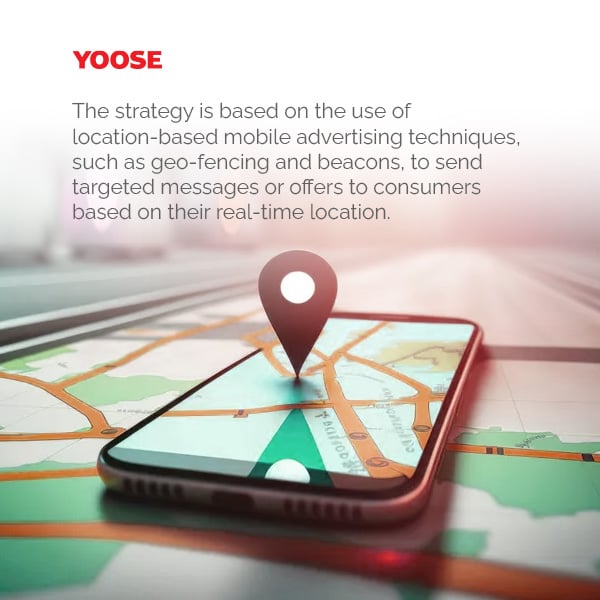
How does it work in general?
Here's how it works:
Identifying Competitor Locations: The first step is to identify your competitors and their locations. These locations could be physical stores, restaurants, service centers, etc.
Geo-fencing: Once the competitor locations have been identified, the next step is to set up a geo-fence around these locations. A geo-fence is a virtual boundary that can be set up around a specific geographical area. When a potential customer enters this geo-fenced area, it triggers an action such as a push notification or an SMS message.
Targeted Ads: Once a potential customer enters a geo-fenced area, they can be served with targeted ads or offers. These ads or offers are designed to entice the customer away from the competitor and towards your business. The ads could be for a special discount, a unique product, or any other offer that might appeal to the customer.
Conversion: The final step is the conversion, where the potential customer takes action based on the targeted ad or offer. This could be visiting your store, making a purchase, or any other desired action.
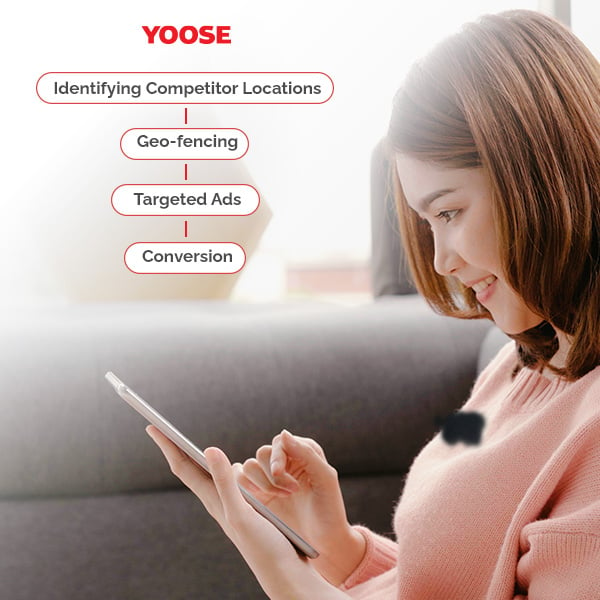
What is the difference between geofencing and geo-conquesting?
Geofencing is a location-based digital marketing tool that lets marketers send messages to smartphone users in a defined geographic area. For example, a store could set up a geofence centered around its location to send a notification to people within a certain radius to come and visit their store, perhaps offering a special deal or discount. The purpose of this is to target potential customers who are in the vicinity of the business, making them aware of the business and what it offers and encouraging them to visit.
Geofencing creates a virtual boundary around a real-world geographical area. When a mobile device enters (or exits) this area, it triggers the delivery of some form of content - often an alert, notification, or ad. This content might be a promotion, sale, or special event happening in the store. It could also be a notification about a new product or service being offered.
Geo-conquesting, on the other hand, is a more aggressive and strategic use of geofencing. It involves setting up geofences, not around your own business, but around those of your competitors. The goal here is to 'conquest' customers who are currently at or have recently visited a competitor's location.
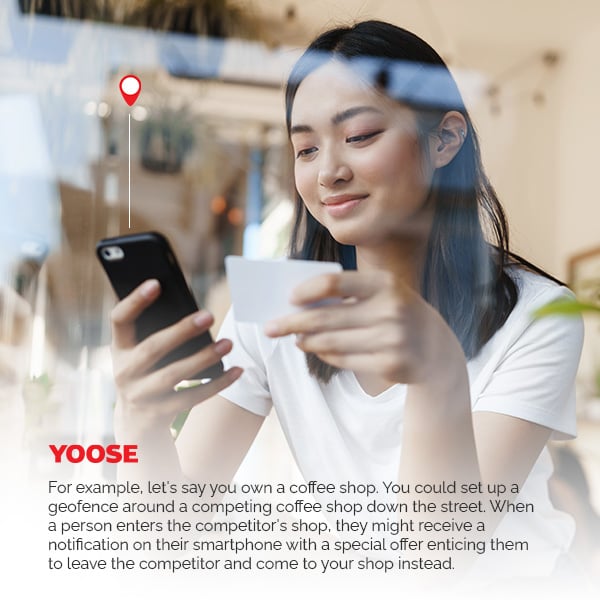
For example, let's say you own a coffee shop. You could set up a geofence around a competing coffee shop down the street. When a person enters the competitor's shop, they might receive a notification on their smartphone with a special offer enticing them to leave the competitor and come to your shop instead. The idea is to win customers away from your competitors.
So, while geofencing and geo-conquesting use similar technology (both are based on the geographic location of potential customers), their strategies are different:
- Geofencing is about attracting customers who are in your vicinity, potentially interested in your type of business, but not necessarily currently engaging with a competitor.
- Geo-conquesting is about actively trying to win customers away from your competitors by providing them with incentives to choose your business over the competition when they are currently at or near a competitor's location.
How can geo-conquesting be implemented in a business?
Decide on a Platform: Platforms like Google Adwords or Facebook can be used to implement geo-conquesting. On Google Adwords, you can set up your store in 'Radius targeting', and on Facebook, you can 'Drop Pin' your store in the audience settings.
Create Your Advert: These platforms allow you to create ads to be sent out to all those who pass through your "fence" (a virtual boundary set up around a certain location, like your store). These ads need to be more creative than your standard adverts and should focus on what your business has to offer that your competitors don’t.
Leverage Your Website or App: You can add links to your website or company's app in the ads. This could be a great way to bring in new customers. If your company offers delivery services, you can teach your new customers how they can take advantage of your business from their own homes.
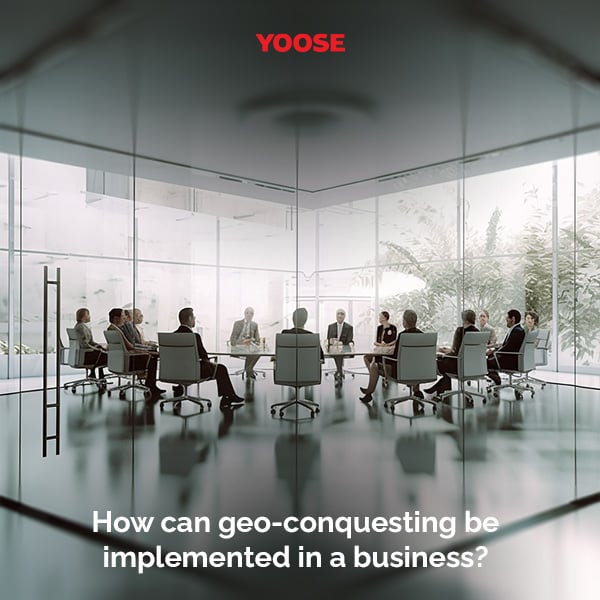
However, these are just the initial steps. Implementing a successful geo-conquesting strategy also involves monitoring, adjusting, and optimizing your campaigns based on data and feedback, as well as ensuring that your business is ready to handle any increase in customers and that your customer service is top-notch.
Can geo-conquesting help increase brand awareness?
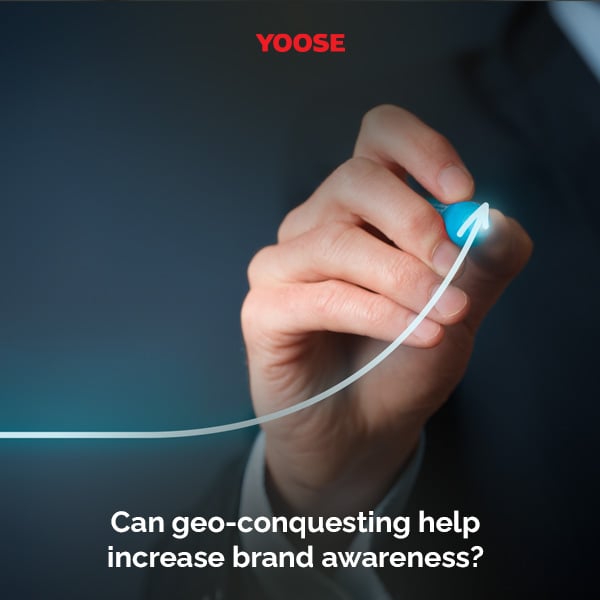
Yes, geo-conquesting can be an effective tool for increasing brand awareness. By reaching customers when they're in or have just left a competitor's location, a business can introduce its brand to potential customers who may not have been aware of it before.
Geo-conquesting works by sending notifications or advertisements to potential customers when they are in or near a competitor's location. This means that even if these individuals were not previously aware of the brand, they will become aware of it when they receive these notifications.
For example, suppose someone is in a bookstore owned by a large chain. A local independent bookstore could use geo-conquesting to send a notification to that person's phone, offering a discount or highlighting a unique feature of their store. Even if the person doesn't immediately leave the chain store to go to the independent bookstore, they now know that the other store exists and what it offers.
Over time, repeated exposure to these types of notifications can help to build brand awareness. If people continue to see ads or receive notifications from the same company, they are likely to become more familiar with that brand. This can ultimately increase the likelihood that they will think of that brand in the future when they are in need of the products or services it offers.
Moreover, if the geo-conquesting advertisements highlight unique aspects of the brand, this can help to create a distinctive brand image in the minds of consumers. This can also contribute to increased brand awareness.
However, like any marketing strategy, the success of geo-conquesting in increasing brand awareness will depend on a variety of factors, including the quality of the advertisements, the relevance of the offers to the targeted consumers, and the overall market conditions.
Can geo-conquesting be used to take advantage of competitors' negatives?
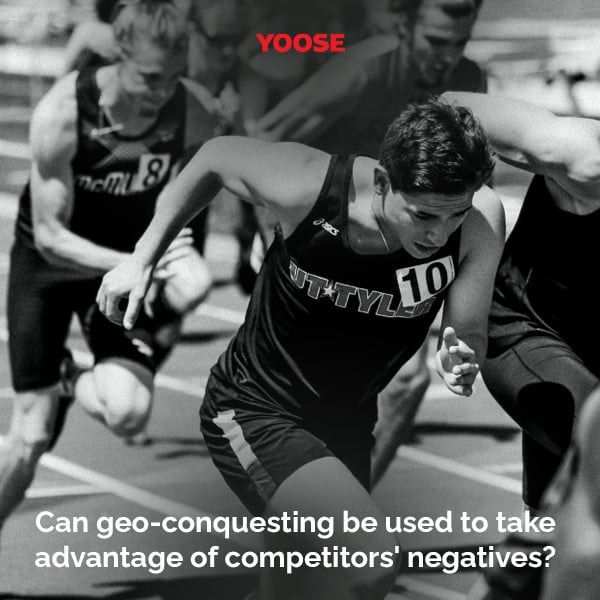
Yes, geo-conquesting can be used to take advantage of competitors' negatives. The essence of geo-conquesting is to "conquer" customers from rival businesses by luring them away with attractive deals or superior service. If a competitor has certain weak points or negative aspects, geo-conquesting can highlight how your business offers a better alternative.
For example, let's imagine a scenario where a customer is waiting in a long queue at a competitor's store. If your business offers a faster service or shorter wait times, a geo-conquesting notification could be sent to the customer's smartphone, encouraging them to leave the queue and come to your store instead. In this way, the competitor's negative aspect (long waiting times) is used to your advantage.
Moreover, if there are negative reviews or widespread complaints about a competitor's product or service, you can use geo-conquesting to emphasize how your business does better in those areas. For instance, if a restaurant competitor is frequently criticized for its poor service, a geo-conquesting ad from your restaurant could highlight your friendly and attentive staff.
However, it's important to be careful when using this strategy. While it can be effective, focusing too much on a competitor's negatives rather than your own positives can come off as overly aggressive or negative itself. It's generally more effective to use geo-conquesting to highlight your own strengths and unique selling propositions, rather than just pointing out competitors' weaknesses.
What are the benefits of geo-conquesting?
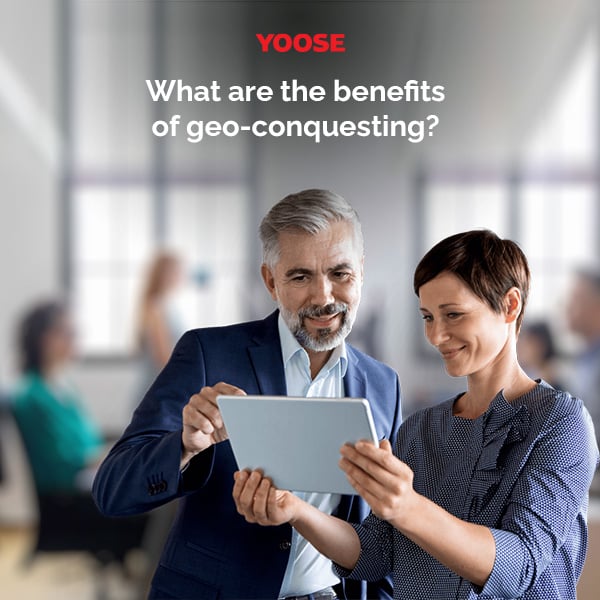
Geo-conquesting offers several benefits, particularly in the realm of marketing and customer acquisition. These include:
Targeted Advertising: Geo-conquesting allows businesses to target customers who are physically near their location or at the location of a competitor. This ensures that advertising efforts are reaching individuals who are likely to be interested in the products or services the business offers.
Increased Brand Awareness: By reaching out to customers who are in the vicinity of a competitor's store, businesses can increase awareness of their brand among individuals who may not have previously considered them as an option.
Taking Advantage of Competitors' Negatives: If a competitor's store is experiencing issues, such as long queues or poor service, businesses can use geo-conquesting to attract disgruntled customers by offering a better experience.
Attracting New Customers: Geo-conquesting can help businesses attract new customers by reaching out to individuals who have visited a competitor's store or location but have not yet visited their own. This can be an effective way of expanding a customer base and increasing sales.
Improved Customer Data: By tracking the movements of potential customers, businesses can gather valuable data about consumer behavior. This data can be used to improve marketing strategies, product offerings, and customer service.
Increased Sales and Revenue: Ultimately, the goal of geo-conquesting is to increase sales and revenue by drawing customers away from competitors and towards your own business. By offering targeted deals and incentives, businesses can encourage potential customers to choose them over their competitors.
Creativity and Customization: Geo-conquesting allows businesses to create highly customized and creative marketing campaigns. For example, a business could target individuals who visit a particular type of location, like a sports stadium or a park, with specific offers related to the interests of the people likely to visit those locations.
Cost-Effective Marketing: Because geo-conquesting allows for very specific targeting, it can be a cost-effective marketing strategy. Businesses can ensure their advertising budget is being spent on reaching individuals who are likely to be interested in what they have to offer, rather than wasting money on broad, non-targeted advertising campaigns.
Remember, while geo-conquesting can be a powerful tool, it's important to consider privacy concerns and ensure that any marketing strategies respect the privacy and personal data of potential customers.
An simple strategy for Geo conquesting
Here's a hypothetical example of a geo-conquesting strategy for a local coffee shop:
Let's call our coffee shop "Java Joys."
Identify Competitors: First, Java Joys identifies its primary competitors in the area. These might include other local coffee shops as well as national chains like Starbucks and Dunkin'.
Set up Geo-Fencing and Geo-Conquesting: Java Joys uses a mobile advertising platform to set up a geo-fence around its own location. Then, it sets up geo-conquesting for the locations of its identified competitors.
Develop Advertisements: Java Joys creates mobile advertisements that highlight its unique offerings. This could be special deals (e.g., "10% off your first order"), unique products (e.g., "Try our exclusive locally-sourced blend"), or other features that distinguish Java Joys from its competitors (e.g., "Free, high-speed Wi-Fi for all customers").
Target Customers: Whenever a potential customer enters a competitor's location, they receive a notification on their mobile device with one of Java Joys' ads. For example, if someone walks into a nearby Starbucks, they might get a notification saying, "Why settle for ordinary? Enjoy 10% off your first order at Java Joys, just around the corner!"
Retarget Based on Past Visitation History: Java Joys also uses the mobile advertising platform to target customers based on their past visitation history. If someone has visited Starbucks in the past but has never visited Java Joys, they might receive a notification inviting them to try out Java Joys the next time they're in the area.
Analyze and Adjust: Java Joys continually analyzes the effectiveness of its geo-conquesting campaign. Which ads are most effective at drawing customers away from competitors? Which competitors' customers are most likely to switch to Java Joys? Based on this data, Java Joys can adjust its strategy to maximize the effectiveness of its geo-conquesting campaign.
By implementing this geo-conquesting strategy, Java Joys aims to increase its customer base and draw business away from its competitors. It's a strategy that requires careful planning and ongoing analysis, but when done effectively, it can be a powerful tool for gaining a competitive edge in a crowded marketplace.
A real case of Burger King
Summary
Burger King's Whopper Detour Campaign allows customers to get a Whopper for one cent at McDonald's when they order through the Burger King app.
Highlights
- 🍔 Burger King's Whopper Detour Campaign offers a Whopper for one cent at McDonald's.
- 💻 Customers can only access the deal through the Burger King app.
- 📱 The campaign aims to increase usage of the Burger King app.
- 🤔 Some customers are confused by the campaign and are unable to find a nearby Burger King.
- 🙌 The idea behind the campaign is to show that Burger King is committed to doing things differently.
- 🚀 The campaign was successful and led to a 37% increase in app downloads.
Conclusion
In conclusion, geo-conquesting has proven to be a powerful marketing tactic for businesses looking to increase brand awareness, attract new customers, and gain a competitive edge. However, successfully implementing geo-conquesting requires expertise and technological know-how, which is where YOOSE comes in. Our team specializes in location-based marketing and can help businesses maximize the benefits of geo-conquesting.
At YOOSE, we utilize the latest technology and data analytics to support your business growth. Our team of experts can help you create customized and effective geo-conquesting campaigns that target your ideal customers. We offer free consultations to help you get started and ensure that your campaigns are tailored to meet your specific business goals.
By partnering with YOOSE, businesses can take advantage of the benefits of geo-conquesting without the hassle of managing complex marketing campaigns. Whether you're a small business looking to expand your customer base or a large corporation seeking to gain a competitive advantage, YOOSE can help you achieve your marketing goals through targeted and effective geo-conquesting campaigns. Contact us today to learn more about how we can help your business grow.

